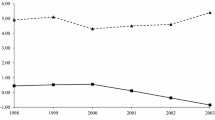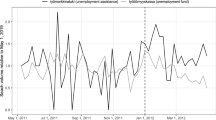Abstract
The purpose of this paper is to simultaneously investigate whether the active labour market programmes (ALMPs) and the imposition of benefit sanctions help unemployed insured workers in Denmark to find a job sooner than those who do not get any activation. Earlier studies have modelled ALMPs and benefit sanctions separately, which may have resulted in over- or underestimation of the true effect. As part of our empirical methodology, we used a multivariate mixed proportional hazard model and optimally selected the number of support points for the specification of unobserved heterogeneity distribution in our sample. Our results revealed that the impositions of both benefit sanctions and employment subsidies in the private sector have a positive impact on reducing unemployment duration. Some policy implications are drawn.

Similar content being viewed by others
Notes
The detail discussion about characteristics are presented in Section 4 ‘Data and Descriptive Analysis’.
We are very grateful to reviewer for improving our explanation about these scenarios.
Sanctions data for individuals on social assistance are only available from 2007, and we do not have access to that data set.
ALMPs is a special offer given to unemployed insured individuals only. Additionally, those who are not insured cannot get UI benefits but social assistance (SA). However, individuals receiving SA can participate in ALMPs and can get guidance from the public employment service (PES) for job search.
There are 32 different UI funds in Denmark. They each represent different levels and types of education. UI funds that operate across types of education and industries have emerged and the main part of the UI recipients are however still organised according to their main education and occupation National Directorate of Labour (2006).
The UI funds are under supervision by the National Directorate of Labour, which may imply minor differences in the administration of the rules. There are, however, still rather larger discrepancies, as will be clear later in the paper.
In Danish: Bekendtgørelse om rådighed and Bekendtgørelse om selvforskyldt ledighed, June 172,003.
The Danish labour directorate tried to map individuals who leave public income transfer to employment, and they found that more than 90% move to employment.
In practice, an individual is registered to have become employed when the individual has not collected benefits for four consecutive weeks.
We choose January 2003 as a starting point, because major regulation on sanction changes on this date. These changes imply a stricter set of requirements and that the number of sanctions per unemployed individual increases afterwards. To have a period of comparable rules we disregard the period prior to 2003.
For details, see Isaksen et al. (Isaksen and Karlsen 2012).
We also carried out an analysis including the 10-week sanction. The main results are unaffected by this but, not surprisingly, the magnitude of the effects is somewhat smaller when they are left out.
For details on the Youth programme, see Jensen et al. (2003).
Marital status is defined if an individual is unmarried and does not cohabit either.
We have two indicators for whether the individual is an immigrant from more or less developed countries. The reference category is native Danes.
For the UI funds, we have a set of indicators for unemployment insurance fund membership. There are 32 UI funds in Denmark, and membership is in most cases categorised according to education/skills and/or by industry. These funds may be seen as broad proxies for the missing information concerning education and skills. Most UI funds only accept members with certain types of education or people who work in certain types of industries. Take, for example, a trained economist. She will qualify for membership of the UI fund for academics, but not for the mental workers UI fund. This observation is important in the subsequent analysis.
For detail about timing-of-events method, see Abbring et al. (2005).
We also verified the model selection based on the Bayesian Information Criterion (BIC), and the results are coincided with the AIC.
The Broyden–Fletcher–Goldfarb–Shanno algorithm is an iterative method for solving unconstrained nonlinear optimization problem.
The detail results on other transitions including all explanatory variables for men and women can be found in Table B3 and B4 respectively.
It is a non-linear model where parameter estimates cannot be directly interpreted, therefore, the percentage effect is calculated by using this formula: =(eβ − 1) × 100. For example, in the case of sanction, the parameter estimate is 0.538 and the percentage effect is 71.2% {=(e0.538 − 1) × 100}. All parameter estimates are interpreted in terms of percentage. The detail results are available upon request to the authors.
References
Abbring JH, Berg GJ, Ours JC (2005) The effect of unemployment insurance sanctions on the transition rate from unemployment to employment. Econ J 115:602–630
Abbring JH, van den Berg GJ (2003) The nonparametric identification of treatment effects in duration models. Econometrica 71:1491–1517
Arni P, Lalive R, van Ours JC (2013) How effective are unemployment benefit sanctions? Looking beyond unemployment exit. J Appl Econ 28:1153–1178
Bergemann A, Caliendo M, van den Berg GJ, Zimmermann KF (2011) The threat effect of participation in active labor market programs on job search behavior of migrants in Germany. Int J Manpow 32:777–795
Boone J, van Ours JC (2006) Modeling financial incentives to get the unemployed back to work. J Instit Theoret Econ JITE 162:227–252
Caliendo M, Mahlstedt R, Mitnik OA (2017) Unobservable, but unimportant? The relevance of usually unobserved variables for the evaluation of labor market policies. Labour Econ 46:14–25
Calmfors L, Forslund A, Hemstrom M (2002) Does active labour market policy work? Lessons from the Swedish experiences
Card D, Kluve J, Weber A (2010) Active labour market policy evaluations: a meta-analysis. Econ J 120:F452–F477
Card D, Kluve J, Weber A (2015) What works? A meta analysis of recent active labor market program evaluations. National Bureau of Economic Research
Filges T, Smedslund G, Jørgensen A-MK (2015) Active labour market programme participation for unemployment insurance recipients: a systematic review. Res Soc Work Pract, 1049731516630385
Gaure S, Røed K, Zhang T (2007) Time and causality: a Monte Carlo assessment of the timing-of-events approach. J Econ 141:1159–1195
Graversen BK, Larsen B (2013) Is there a threat effect of mandatory activation programmes for the long-term unemployed? Empir Econ:1–21
Heinesen E, Husted L, Rosholm M (2013) The effects of active labour market policies for immigrants receiving social assistance in Denmark. IZA J Migrat 2:15
Holm A, Høgelund J, Gørtz M, Rasmussen KS, Houlberg HSB (2017) Employment effects of active labor market programs for sick-listed workers. J Health Econ 52:33–44
Isaksen A, Karlsen J (2012) Combined and complex mode of innovation in regional cluster development: analysis of the light-weight material cluster in Raufoss, Norway. Interactive learning for innovation. Springer
Jensen P, Rosholm M, Svarer M (2003) The response of youth unemployment to benefits, incentives, and sanctions. Eur J Polit Econ 19:301–316
Jespersen ST, Munch JR, Skipper L (2008) Costs and benefits of Danish active labour market programmes. Labour Econ 15:859–884
Koning JD, Peers Y (2007) Evaluating active labour market policies evaluations
Lalive R, Ours JC, Zweimüller J (2005) The effect of benefit sanctions on the duration of unemployment. J Eur Econ Assoc 3:1386–1417
Lalive R, van Ours JC, Zweimüller J (2008) The impact of active labour market programmes on the duration of unemployment in Switzerland. Econ J 118:235–257
Laužadytė A (2010) The effects of active labour market Programmes on unemployment duration. Ekonomika, 89
Lindley J, Mcintosh S, Roberts J, Murray CC, Edlin R (2015) Policy evaluation via a statistical control: a non-parametric evaluation of the ‘Want2Work’active labour market policy. Econ Model 51:635–645
National Directorate Of Labour (2006) Rådighedsstatistikken 2005 -- Rådigheden hos Forsikrede Ledige. Denmark
Røed K, Westlie L (2012) Unemployment insurance in welfare states: the impacts of soft duration constraints. J Eur Econ Assoc 10:518–554
Rønsen M, Skarðhamar T (2009) Do welfare-to-work initiatives work? Evidence from an activation programme targeted at social assistance recipients in Norway. J Eur Soc Policy 19:61–77
Rosholm M, Svarer M (2008) The threat effect of active labour market programmes. Scand J Econ 110:385–401
Svarer M (2011) The effect of sanctions on exit from unemployment: evidence from Denmark. Economica 78:751–778
The Ministry of the Interior and Health (2005) The local government reform. Denmark
van den Berg GJ, van der Klaauw B, van Ours JC (2004) Punitive sanctions and the transition rate from welfare to work. J Labor Econ 22:211–241
Author information
Authors and Affiliations
Corresponding author
Ethics declarations
Conflict of Interest
All three authors confirm that in this paper there is no conflict of interests to report and that there is no funding to report.
Additional information
Publisher’s Note
Springer Nature remains neutral with regard to jurisdictional claims in published maps and institutional affiliations.
Appendices
Appendix A: Literature summary and descriptive statistics
Appendix B: Results about the optimum selection of mass point
Rights and permissions
About this article
Cite this article
Ahmad, N., Svarer, M. & Naveed, A. The Effect of Active Labour Market Programmes and Benefit Sanctions on Reducing Unemployment Duration. J Labor Res 40, 202–229 (2019). https://doi.org/10.1007/s12122-019-09288-x
Published:
Issue Date:
DOI: https://doi.org/10.1007/s12122-019-09288-x




